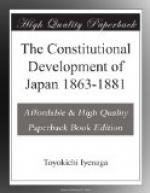CHAP. IV. INFLUENCES THAT SHAPED THE GROWTH OF THE REPRESENTATIVE IDEA OF GOVERNMENT
John Stewart MILL’S enumeration
of the social conditions necessary
for
the success of representative
government
Japan of 1871 not yet ready for the adoption of representative government
Political activity of A nation not isolated from other spheres of its activities
Japan’s political development greatly aided by her social, educational, industrial and religious changes
Sketch of the development of these non-political institutions from 1868 to 1881
1. Means of Communication
a. Telegraph b. Postal System c. Railroad d. Steamers and the Coasting Trade
2. Educational Institutions
3. Newspapers
CHANGES IN LAW AND RELIGION
CHAP. V. (1871-1881). PROGRESS OF THE CONSTITUTIONAL MOVEMENT FROM THE ABOLITION OF FEUDALISM TO THE PROCLAMATION OF OCTOBER 12, 1881
LEADERS OF THE RESTORATION
EFFECT OF THE OVERTHROW OF FEUDALISM
THE IWAKURA EMBASSY
IWAKURA, ITO, INOUYE
FUKUZAWA
THE PRESS AND ITS INFLUENCES
RI-SHI-SHA AND COUNT ITAGAKI
MEMORIALS OF RI-SHI-SHA TO THE EMPEROR
ESTABLISHMENT OF LOCAL ASSEMBLIES
The proclamation of October 12, 1881, to establish A parliament in 1890
INTRODUCTORY.
The power which destroyed Japanese feudalism and changed in that country an absolute into a constitutional monarchy was a resultant of manifold forces. The most apparent of these forces is the foreign influence. Forces less visible but more potent, tending in this direction, are those influences resulting from the growth of commerce and trade, from the diffusion of western science and knowledge among the people, and from the changes in social habits and religious beliefs. The truth of the solidarity of the varied interests of a social organism is nowhere so well exemplified as in the history of modern Japan. Her remarkable political development would have been impossible had there been no corresponding social, educational, religious, economic and industrial changes. In order to trace the constitutional development of New Japan, it is therefore necessary:




